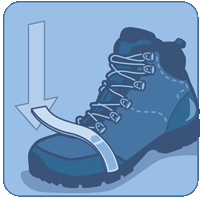Gear School 2009: Boots
Soaked, scuffed, and beat up? We'll show you how to get your trusty footwear back to trail-ready.
Fast Fixes … At Home
Problem Toxic odors
Solution Wet, dirty insoles are often the culprit. “After each trip, clean them with a toothbrush and water,” says repair expert Dave Page. Still smelly? Wipe the interior with a 3:1 solution of water and white vinegar. Loosely pack with newspaper to absorb moisture and turn upside-down. Change daily until dry.
Problem Caked-on grime
Solution Dirt and salt are like Brillo. “Scrub muddy boots with a veggie brush,” advises Page.
Problem Dried-out leather
Solution Condition boots when they get stiff or light in color, says Komito Boots owner Steve Komito. Our favorite treatments are water-based (Nikwax Conditioner for Leather; $8, nikwax.com) or silicone (Aquaseal Leather Waterproofing; $6, aquaseal.com) because they don’t inhibit breathability. When that’s not an issue (e.g., snow boots), wax conditioners (Sno-Seal; $6, atsko.com) last longer. Read labels to ensure the goop is right for your boot’s leather.


Problem Scuffed toes
Solution Make your own toe cap. Clean the area with an alcohol pad, let dry, then apply masking tape to create an edge. Rough the toe with sandpaper, then buff with alcohol twice. Apply a smooth coat of Freesole ($6, mcnett.com); wait 45 minutes to peel off tape.
Fast Fixes … In the Field
Problem Soaked boots
Solution “Never subject boots to extreme heat, such as a campfire,” says Page. “Not only can you shrink them a size, you might melt adhesives or burn the upper.” To dry them, remove the insoles, open the laces, and put chemical warming packs inside. No artificial heat? Stash your boots at the bottom of your bag overnight, or turn them upside-down on trekking poles.
Problem Flapping sole or heel
Solution Reattach it with Freesole ($6, mcnett.com). Wrap duct tape around the area and let glue dry overnight, inserting a pen to increase pressure.


BOOT FIT TIPS: 4 Steps To Pain-Free Hiking
1. Ignore the numbers and buy the pair that feels the best–even if it’s not your normal size.
2. Consider replacing the boot’s standard footbeds with aftermarket insoles, such as Sole’s Softec ($45, yoursole.com). They can add arch support, prevent end-of-day soreness, and help low-volume feet fit into standard boots.
3. Less weight translates to more comfort: Don’t buy heavy-duty boots if you primarily hike with a light pack on mellow trails.
4. Break in boots thoroughly by wearing them around the house and on short dayhikes. Light hikers will be ready in a few days, but heavier, all-leather boots require a few weeks of wear.

The Wet Foot Test
Try this to determine if you need extra arch support in your boots. Completely wet the sole of your foot, then step onto a paper bag. If you can see an imprint of most of your arch, you could benefit from stabilizing insoles (only about half of the arch will be visible if you have normal feet).
WHEN TO CALL AN EXPERT
Some problems are worth fixing but beyond your DIY skills–such as a hole in the upper, broken lace hardware, or worn-out soles on high-end backpacking boots. Call Dave Page (800-252-1229, davepagecobbler.com) or Komito Boots (800-422-2668) for professional repair.
WHEN TO CALL IT QUITS
Get new kicks if: Leather uppers have been worn extremely thin or are severely degraded (due to mildew or too much conditioning); shanks are broken; or the treads on a pair of low-cuts are worn out.